RTL Group Bundle
How Did RTL Group Shape European Broadcasting?
Ever wondered how a single company could revolutionize the way Europe consumes media? RTL Group, a titan in the European broadcasting scene, boasts a rich and compelling history. From its humble beginnings in 1931, this RTL Group SWOT Analysis reveals a story of innovation and strategic adaptation.
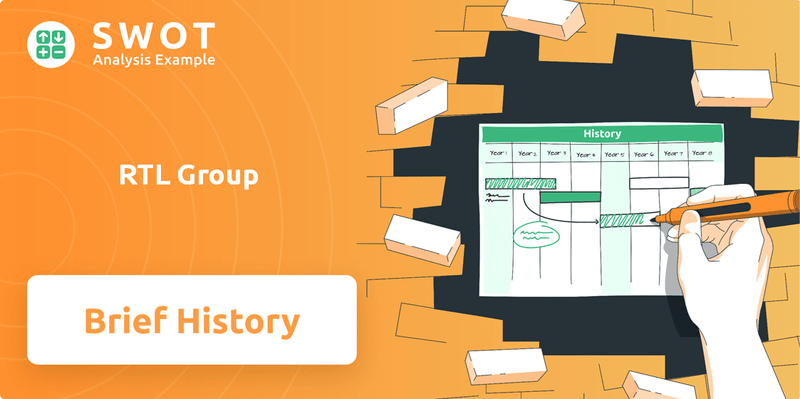
The RTL company's journey began with a bold vision: cross-border radio broadcasting. This pioneering spirit propelled RTL Group's evolution, transforming it from a Luxembourg-based radio station into a leading European media company. Understanding the RTL history is crucial for anyone interested in the media landscape and the influence of companies like Bertelsmann in shaping European broadcasting.
What is the RTL Group Founding Story?
The RTL Group, a prominent media company, traces its origins back to May 11, 1931. This marked the establishment of Compagnie Luxembourgeoise de Radiodiffusion (CLR), setting the stage for a significant player in European broadcasting. The early days saw a strategic vision to leverage Luxembourg's unique position for cross-border radio broadcasts.
The founders, a consortium of French and Luxembourgish business interests, saw an opportunity to bypass the strict national broadcasting monopolies prevalent in countries like France, Germany, and Belgium. Their goal was to create a privately-owned radio station capable of reaching a wide audience across these borders. This innovative approach laid the foundation for what would become a major media conglomerate.
The primary business model revolved around commercial radio broadcasting, with advertising as the main revenue source. Radio Luxembourg, the flagship station, quickly became one of Europe's first commercial radio stations. The name, 'Compagnie Luxembourgeoise de Radiodiffusion,' clearly indicated its origin and core activity. Securing broadcasting rights and frequencies amidst the complex political landscape of interwar Europe was a major hurdle.
The RTL Group's founding was driven by a consortium of French and Luxembourgish business interests, capitalizing on Luxembourg's strategic location for broadcasting.
- Founded on May 11, 1931, as Compagnie Luxembourgeoise de Radiodiffusion (CLR).
- Focused on commercial radio broadcasting, with Radio Luxembourg as its flagship station.
- Navigated the complex regulatory environment of interwar Europe to secure broadcasting rights.
- Primarily funded by a consortium of investors.
The early success of Radio Luxembourg set the stage for the future growth of the RTL Group. The company's ability to overcome initial challenges, such as securing broadcasting rights, was crucial. For more information about the company's ownership, you can read this article about Owners & Shareholders of RTL Group.
RTL Group SWOT Analysis
- Complete SWOT Breakdown
- Fully Customizable
- Editable in Excel & Word
- Professional Formatting
- Investor-Ready Format
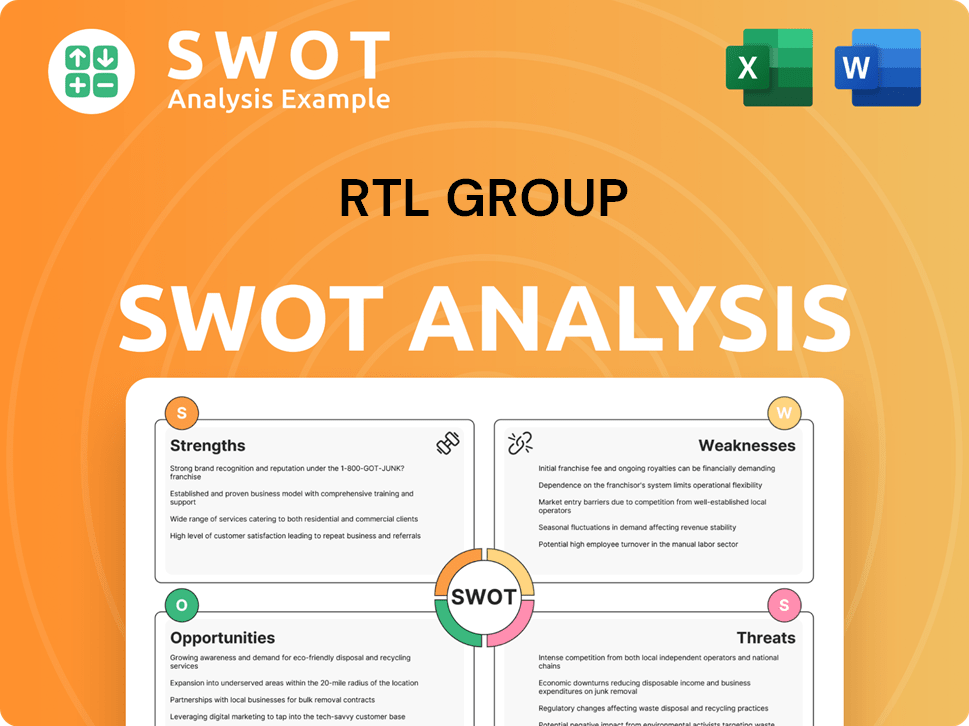
What Drove the Early Growth of RTL Group?
The early growth of the RTL Group, formerly CLR, was marked by significant milestones. The company, which has a rich RTL history, started in 1931 with Radio Luxembourg, quickly gaining popularity across Europe. This laid the foundation for its expansion into a major European broadcasting and media company.
Radio Luxembourg became a hit due to its innovative commercial programming. This strategy helped it to attract a large audience across different European countries. The station's success was a crucial factor in the company's early growth and its ability to compete with state-controlled broadcasters.
A pivotal moment in RTL's history was the launch of Télé Luxembourg in 1955. This move into television set the stage for its future as a multimedia powerhouse. This expansion was a strategic decision that helped position RTL as a leader in the evolving media landscape.
During the 1960s and 1970s, RTL continued its expansion by establishing and acquiring television and radio operations across Europe. This was often achieved through strategic partnerships, focusing on cross-border broadcasting. The company's approach allowed it to build a strong pan-European presence.
RTL's commercial model was well-received, offering an alternative to state-controlled broadcasters. Initially, the competitive landscape was dominated by national public broadcasters. However, RTL's approach allowed it to carve out a unique niche, shaping its trajectory towards becoming a diversified media group. Read more about the Growth Strategy of RTL Group.
RTL Group PESTLE Analysis
- Covers All 6 PESTLE Categories
- No Research Needed – Save Hours of Work
- Built by Experts, Trusted by Consultants
- Instant Download, Ready to Use
- 100% Editable, Fully Customizable
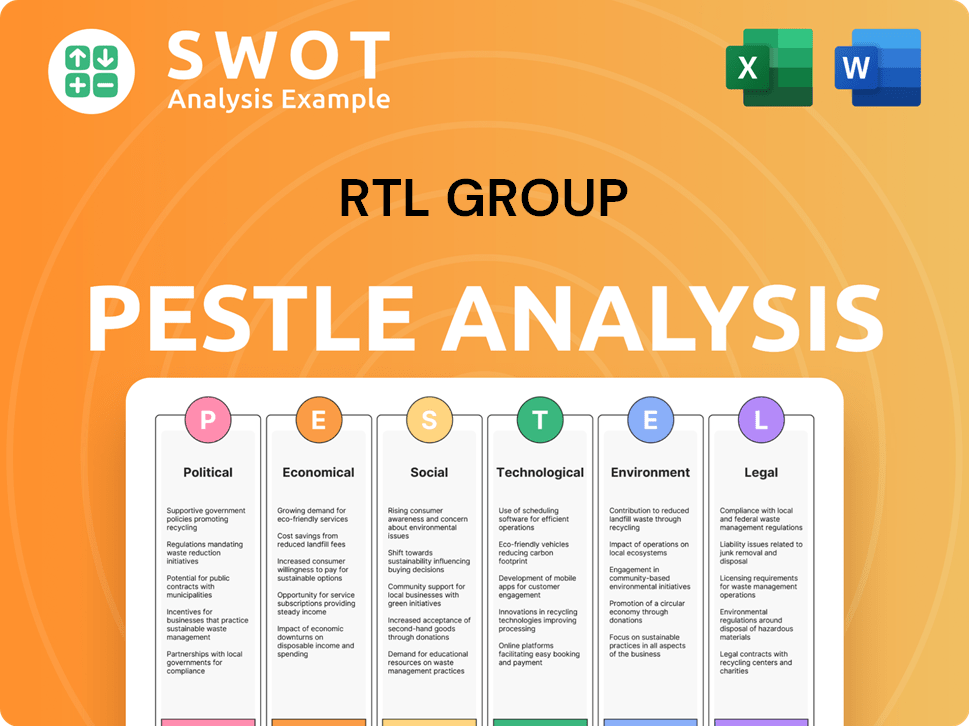
What are the key Milestones in RTL Group history?
The history of RTL Group, a prominent media company, is marked by significant milestones that have shaped its trajectory in European broadcasting. From its early days to its current position, RTL Group has consistently adapted to the evolving media landscape, establishing itself as a key player in the industry. The company's journey reflects broader trends in media, including the liberalization of broadcasting markets and the digital revolution.
| Year | Milestone |
|---|---|
| 1931 | RTL Group's origins trace back to the founding of Compagnie Luxembourgeoise de Radiodiffusion, marking the beginning of its venture into broadcasting. |
| 1955 | Launch of Télé Luxembourg, a pioneering move as the first private broadcaster in the region, setting a precedent for commercial television. |
| 1990s | Expansion through strategic partnerships and acquisitions, solidifying RTL Group's presence across Europe and beyond. |
| 2000s | Focus on digital transformation and content diversification, adapting to changing audience consumption habits and technological advancements. |
| 2024-2025 | Continued investment in streaming services, such as RTL+, to compete with global players and expand its digital footprint. |
RTL Group has been at the forefront of innovation in the media sector. The company's early adoption of satellite broadcasting expanded its reach significantly. It has also been a leader in developing diverse programming formats, catering to a wide range of audiences.
RTL Group was instrumental in breaking state monopolies in Europe, introducing a new model for media financing through commercial broadcasting. This shift allowed for greater competition and diversity in programming, influencing the RTL history.
RTL Group leveraged satellite technology early on to broaden its reach, enabling it to broadcast across multiple countries and expand its viewership base. This strategic move was crucial for its international expansion.
The company has consistently invested in creating a wide array of content, from news and entertainment to sports and lifestyle programming, catering to diverse audience preferences. This diversification helped to maintain audience engagement.
RTL Group formed key partnerships with local media entities across Europe to establish new channels and extend its market presence. These collaborations were essential for its growth.
RTL Group has made significant investments in digital platforms, including streaming services like RTL+, to adapt to changing audience habits and compete with global streaming giants. This is a key part of its evolution over time.
Implementing a unified RTL branding across various properties has strengthened brand recognition and streamlined its market approach, enhancing its overall market position.
Despite its successes, RTL Group has faced numerous challenges throughout its history. Market downturns and economic recessions have impacted advertising revenues, a primary revenue stream for the company. The rise of new private broadcasters and global streaming services has intensified competition, requiring constant adaptation.
Economic recessions have historically affected advertising revenues, a critical income source for RTL Group. This has necessitated cost-cutting measures and strategic adjustments to maintain profitability.
The media landscape has become increasingly competitive, with the emergence of new private broadcasters and the dominance of global streaming platforms. This has required RTL Group to innovate and differentiate its offerings.
Product failures and content underperformance are inherent risks in the dynamic media industry, demanding continuous adaptation and investment in successful programming. This requires constant market analysis and audience feedback.
Managing a diverse portfolio across multiple countries with varying regulatory environments presents complex internal challenges, requiring strong leadership and strategic oversight. This includes navigating different legal and cultural landscapes.
The shift towards digital consumption and the rise of streaming services have disrupted traditional broadcasting models, necessitating significant investments in digital platforms and content creation. This includes adapting to new content distribution methods.
Changes in media regulations across different European countries can impact RTL Group's operations, requiring the company to adapt its strategies to comply with new rules and guidelines. This includes navigating evolving media policies.
To understand the current market dynamics, you can read more about the Target Market of RTL Group. RTL Group's strategic pivots, such as its push into streaming services, demonstrate its commitment to staying relevant in a rapidly changing media landscape. The company's ability to adapt and innovate has been crucial to its survival and success.
RTL Group Business Model Canvas
- Complete 9-Block Business Model Canvas
- Effortlessly Communicate Your Business Strategy
- Investor-Ready BMC Format
- 100% Editable and Customizable
- Clear and Structured Layout
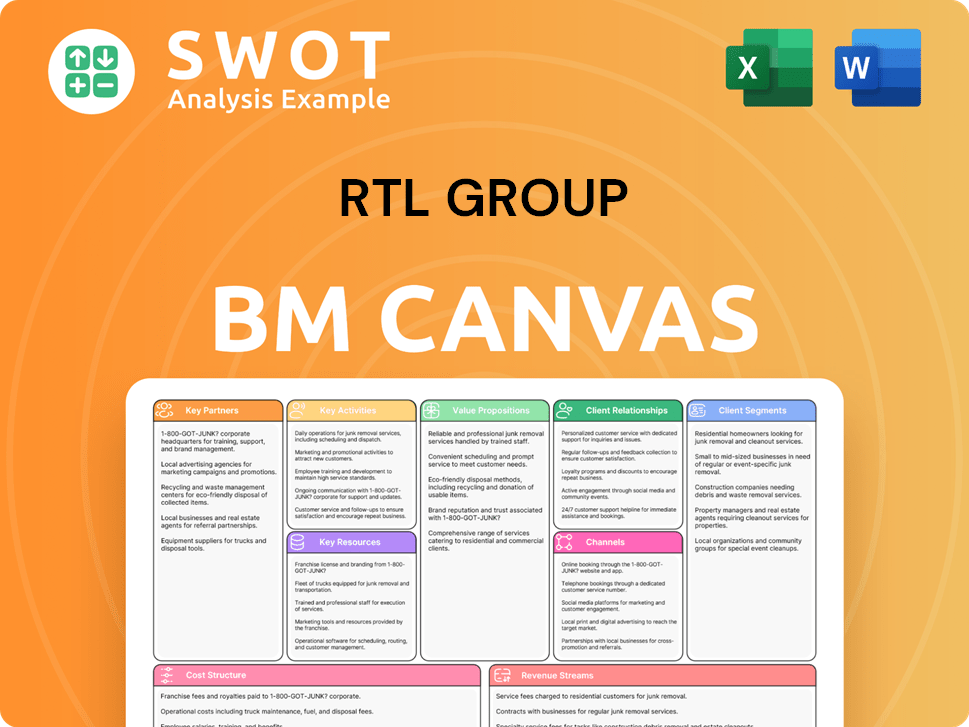
What is the Timeline of Key Events for RTL Group?
The RTL Group history is marked by significant milestones, from its origins in radio broadcasting to its evolution into a major European media company. The company's journey reflects the changing landscape of the media industry, adapting to technological advancements and shifting consumer preferences while expanding its reach and influence across Europe.
| Year | Key Event |
|---|---|
| 1931 | Compagnie Luxembourgeoise de Radiodiffusion (CLR) is founded, launching Radio Luxembourg, marking the start of the RTL history. |
| 1955 | CLR launches Télé Luxembourg, expanding into television broadcasting. |
| 1987 | CLR is rebranded as CLT (Compagnie Luxembourgeoise de Télédiffusion). |
| 2000 | CLT-UFA merges with Pearson TV to form RTL Group. |
| 2001 | RTL Group goes public, listing on the Frankfurt and Luxembourg stock exchanges. |
| 2013 | RTL Group acquires full control of Groupe M6, strengthening its position in France. |
| 2017 | RTL Group announces its 'Total Video' strategy, focusing on digital and streaming. |
| 2021 | RTL Group invests heavily in RTL+ and Videoland to boost its streaming ambitions. |
| 2023 | RTL+ reaches 4.7 million subscribers in Germany, and Videoland reaches 1.3 million in the Netherlands by the end of 2023. |
| 2024 | RTL Group continues to focus on its streaming strategy with ongoing investment in content and platform enhancements. |
RTL Group is heavily invested in its streaming strategy, particularly with RTL+. The company aims to make RTL+ the leading national streaming service in Germany. This involves substantial investment in local content, including fiction, non-fiction, and sports programming to attract and retain subscribers.
The company is exploring further market expansion for its streaming platforms. RTL Group also continues to optimize its linear TV and radio operations. This dual approach allows RTL Group to adapt to the changing media landscape while maintaining its presence across various distribution channels.
Industry trends, such as the shift from linear to on-demand viewing, will significantly impact RTL Group. Analyst predictions suggest continued pressure on traditional advertising revenues, making the success of its streaming ventures crucial for financial performance. The media company faces the challenge of adapting to evolving consumer habits.
Leadership emphasizes data-driven decision-making and technological innovation to stay competitive. The company's strategic initiatives aim to build strong national media champions across Europe. This approach reflects RTL Group's long-term vision of delivering compelling content through diverse digital channels.
RTL Group Porter's Five Forces Analysis
- Covers All 5 Competitive Forces in Detail
- Structured for Consultants, Students, and Founders
- 100% Editable in Microsoft Word & Excel
- Instant Digital Download – Use Immediately
- Compatible with Mac & PC – Fully Unlocked
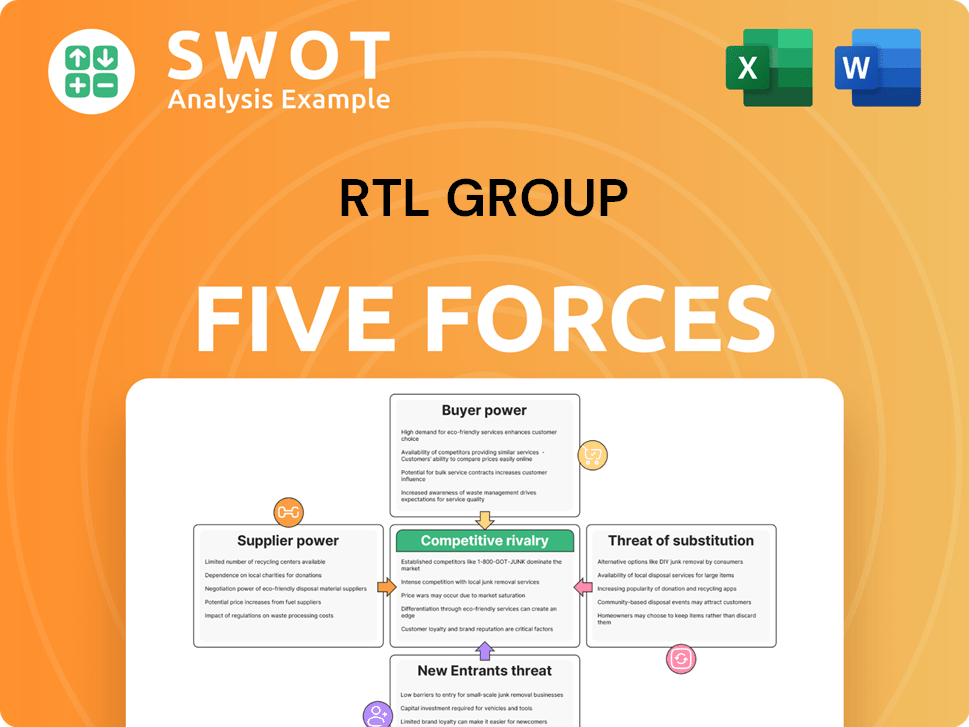
Related Blogs
- What is Competitive Landscape of RTL Group Company?
- What is Growth Strategy and Future Prospects of RTL Group Company?
- How Does RTL Group Company Work?
- What is Sales and Marketing Strategy of RTL Group Company?
- What is Brief History of RTL Group Company?
- Who Owns RTL Group Company?
- What is Customer Demographics and Target Market of RTL Group Company?
Disclaimer
All information, articles, and product details provided on this website are for general informational and educational purposes only. We do not claim any ownership over, nor do we intend to infringe upon, any trademarks, copyrights, logos, brand names, or other intellectual property mentioned or depicted on this site. Such intellectual property remains the property of its respective owners, and any references here are made solely for identification or informational purposes, without implying any affiliation, endorsement, or partnership.
We make no representations or warranties, express or implied, regarding the accuracy, completeness, or suitability of any content or products presented. Nothing on this website should be construed as legal, tax, investment, financial, medical, or other professional advice. In addition, no part of this site—including articles or product references—constitutes a solicitation, recommendation, endorsement, advertisement, or offer to buy or sell any securities, franchises, or other financial instruments, particularly in jurisdictions where such activity would be unlawful.
All content is of a general nature and may not address the specific circumstances of any individual or entity. It is not a substitute for professional advice or services. Any actions you take based on the information provided here are strictly at your own risk. You accept full responsibility for any decisions or outcomes arising from your use of this website and agree to release us from any liability in connection with your use of, or reliance upon, the content or products found herein.